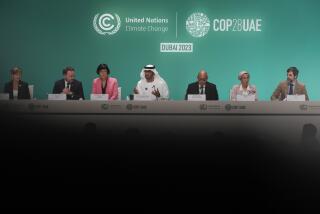Oil Glut Threatening to Swamp OPEC : Factional Infighting Puts Future of Cartel in Doubt, Analysts Say
- Share via
PARIS — The Organization of Petroleum Exporting Countries will meet in Geneva this weekend to face up to the possibility that the market forces its members have helped to unleash have wrecked their cartel.
As oil prices plunge toward $10 a barrel--and some wells begin to shut down in California and Texas--what can OPEC’s 13 members do to push prices back up and restore order in the market? And if OPEC cannot agree on any coherent action that will influence the market, what future does the cartel have?
In the view of a high official at the International Energy Agency in Paris, the “oil directorate” of the major industrial nations, OPEC’s future is not bright.
“It is theoretically possible,” he said, “that a clear and determined decision by OPEC to cut its collective production, say, to 14 or 15 million barrels per day and then stick to it would start the price of oil back up to the $20 price range in the next few months.
“But we know that this is simply not going to happen. There is too much oil sloshing around in the world, and OPEC members were notoriously undisciplined about production quotas even when they were in the driver’s seat two years ago. They will go on scrambling among themselves for markets and cut prices, and it could be anywhere from two to five years before the supply-demand ratio closes and prices return to the $20 level.”
If, as seems apparent, OPEC is neither ready nor able to take action to cut the world oil supply, it will have to wait for market forces to take effect--for lower-priced oil to force the closure of marginal or high-priced production, such as the wells in California and Texas that produce small amounts at a cost of up to $15 per barrel. But it will be some time before this has an effect on the market.
In the meantime, while OPEC is caught up in infighting over how to regain its predominance in the market, the consuming nations of the world are in an upbeat mood, with glowing forecasts of the benefits of lower oil prices spreading into economic recovery.
There has never been any great unity among OPEC’s members. The differences were easy to bury 10 years ago, when the 13 members were providing more than half of the world’s oil and OPEC could fix prices because demand was high and supply was low. But today the OPEC countries account for less than 30% of world production, and for the past two years OPEC has been unable to exercise any firm control on its members in terms of pricing or production.
Now, with supplies readily available and a free market dictating prices, OPEC is breaking up into factional groupings, each trying to corner a share of the market.
At the center is the Persian Gulf bloc, led by Saudi Arabia and including Kuwait, Qatar, the United Arab Emirates and Iraq, with non-OPEC members Egypt, Oman and Bahrain cooperating on the fringes.
Collectively, this OPEC inner circle has the largest oil reserves in the world and, with the exception of Egypt, small populations to worry about. The gulf states can adjust their production up or down with minimal domestic effect.
Hard-Line States
Opposed to the gulf moderates and conservatives are the “revolutionaries,” the hard-line states of Libya, Algeria and Iran. These are the states that consistently have refused to adopt price reductions or to comply with production quotas, and they helped bring about the supply glut.
In Latin America, there are OPEC members Venezuela and Ecuador; Mexico, a non-member, is moving toward cooperation with them. In Africa, Nigeria and Gabon are OPEC members; both have large populations and large problems that are totally at odds with the situation in the gulf area. Indonesia is the sole OPEC member in the Pacific, and its resources are nearly depleted.
Even if the oil market were tight, with supplies limited and prices on the rise, it would be difficult for OPEC to work out any coherent market strategy to cover the disparate political and economic interests of its 13 members.
In the weeks leading up to the Geneva meeting, the tendency of OPEC to break up into factional groups has been accelerating. Venezuela has been meeting with Mexico; the “revolutionaries” have met separately, and Iranian Oil Minister Gholamreza Aghazadeh has proposed that OPEC suspend all production for two weeks a month until the market turns around. This suggestion has not been well received by other OPEC members.
Long-Term Strategy
Saudi Arabian’s oil minister, Ahmed Zaki Yamani, appears to be developing within the Gulf Cooperation Council a long-term strategy aimed at bringing about market stability with higher prices.
There is no sign yet that Saudi Arabia is ready to lead a substantial cut in OPEC production. The Saudis seem prepared to go on pumping oil until low prices and a production glut take their toll and production in general begins to slow down.
“Eventually, there will be a common interest among the producers, the oil companies and the governments of the consuming countries to see the oil market stabilize once again at a higher price, probably in the $20-per-barrel range,” an analyst with the International Energy Agency said. “There is the danger that a low oil price which goes on too long could lead to an excessive upsurge of consumption. This could result in the kind of oil scarcity that the industrialized world had to cope with in the 1970s.
“And with low prices there would be neither the investment nor the incentive to develop new production capacities in the world. So, eventually, everybody is going to want to see the oil price recovered to a more sensible economic level. But it looks as if it is going to take time to achieve.”
In an effort to speed the return to a more or less controlled market, the OPEC countries have been all but pleading for cooperation with the non-OPEC producers. They have invited non-members to Geneva for informal talks on March 18, after their own meeting is over. But, so far, only Mexico, Egypt, Oman, Bahrain and possibly Brazil are likely to show up. And these countries will not add much weight even if OPEC’s members are able to agree on what they should do.
The big non-OPEC production is in the North Sea, where Britain and Norway between them pump almost as much oil as Saudi Arabia. Norway was polite enough to send its oil minister to Geneva last month for informal talks with the OPEC president, Venezuelan Oil Minister Arturo Hernandez Grisanti. But that is the extent of Norwegian readiness to line up with OPEC, and Britain, under Prime Minister Margaret Thatcher, is far from even hinting at any talks.
Britain’s minister of state for energy, Alick Buchanan-Smith, even canceled plans to attend a mid-February oil seminar of industrialists and government officials in Norway because a representative of OPEC would also be present. Thatcher is committed to free markets, and OPEC is not going to get any help from Britain in putting the cork back in the production bottle.
North Sea crude can probably stand the price competition for at least a few years. Although development costs for rigs, platforms and drilling in the North Sea are high, when the oil begins to flow it comes out at less than $5 a barrel. Saudi costs are probably less than $3 a barrel.
5% of GNP
Therefore, although the decline in oil revenue from the North Sea is hurting the British treasury, it is not going to force the oil companies to close down or go broke. And oil makes up only about 5% of Britain’s gross national product. Norway, with a much smaller economic base, has been hit much harder by the price fall.
The most vulnerable high-cost producers have been the operators of U.S. strip wells, pumping a relatively few barrels a day, and after that Canadian and Alaskan producers of heavy crude, which is expensive to extract and costly to move by way of semi-Arctic pipelines.
Nobody knows exactly how the Soviet Union fixes the cost of its oil production, but it is one of the highest in the world, and certainly the Soviets are being hard hit by the price drop. They have been getting 60% of their hard currency from the West through oil sales.
OPEC’S SEA OF OIL
Estimated proven reserves, in billions of barrels, as of Jan. 1, 1986
Saudi Arabia. . . 168.8
Kuwait . . . 89.8
Iran . . . 47.9
Iraq . . . 44.1
United Arab Emirates . . . 32.9
Venezuela . . . 25.6
Libya . . . 21.3
Nigeria . . . 16.6
Algeria . . . 8.8
Indonesia . . . 8.5
Qatar . . . 3.3
Ecuador . . . 1.7
Gabon . . . 0.52
Source: Oil & Gas Journal
More to Read
Inside the business of entertainment
The Wide Shot brings you news, analysis and insights on everything from streaming wars to production — and what it all means for the future.
You may occasionally receive promotional content from the Los Angeles Times.










